Prescription Drug Costs in Sweden: 2014-2023
Drug costs increased by over 9% in 2023, but in real terms, Swedish prescription drug costs have been more or less constant over the last few years.
Prescription drug costs, including those for infectious disease treatments, increased by 9% in 2023, reaching 39 billion Swedish kronor (SEK). The recent cost growth exceeds the average annual increase of 5% over the past decade. This data comes from a recent TLV report on prescription drug costs in the Swedish reimbursement system (“Kostnadsutveckling och långsiktigt hållbar finansiering av läkemedel”, 2024).
Drugs driving the increase in costs
Around half of the 2023 drug cost increase (3.2 billion SEK) came from higher spending on treatments targeting cystic fibrosis, cancer, and inflammatory diseases. New drugs that contributed significantly to this growth were reimbursed in 2023 and 2022. TLV also noted that new drugs tend to see substantial cost increases in their first five years after reimbursement, largely stable costs in years 5 to 15, and significant reductions after 15 years due to generic competition.
How about inflation-adjusted prescription drug costs?
While many goods and services have seen sharp price increases over the last few years, prescription drug costs have remained relatively stable in real terms. The figure below shows the nominal (dashed line) and real (solid line) prescription drug costs from 2014 to 2023. Compared to 2014, inflation-adjusted drug costs have risen by 21%, a slightly higher rate than the 18% increase in real healthcare costs for outpatient and inpatient services over the same period.
TLV’s work to control costs
Socialstyrelsen, the National Board for Health and Welfare, has projected that prescription drug costs will likely increase at a higher rate in the coming years, with up to 30% higher costs by 2027 compared to 2023. If these predictions are confirmed, TLV may be assigned additional responsibilities to control costs. The 2024 TLV report highlights current policies such as the "15-year rule" and a stronger focus on reassessing previously reimbursed drugs.
The 15-year rule reduces prices by 7.5% for drugs with 15 years in the reimbursement system without significant generic competition, saving around 30 million SEK in 2023 (i.e., 0.08% of total costs). In addition, six reassessments were completed in 2023, including updates to reimbursement criteria based on price changes, which can lead to more efficient resource use.
TLV’s views on achieving sustainable long-term funding
TLV outlined some key actions for achieving sustainable long-term funding for prescription drugs. Focus areas include dedicating more resources to reassessing drugs already in the reimbursement system and accounting for patient volumes in reimbursement decisions. I have previously discussed TLV’s plans to adjust cost-effectiveness thresholds depending on patient volumes, which has been seen as a way to allow higher ICERs (cost per QALY) for orphan and ultra-orphan drugs. However, this report shows that TLV views this policy as a cost-saving measure, aiming to set lower cost-effectiveness thresholds for drugs with large patient populations. TLV also aims to increase participation in 3-party negotiations with the regions to offer “hidden” discounts from drug producers, addressing concerns raised by the industry about limited access to these negotiations in the current system.




